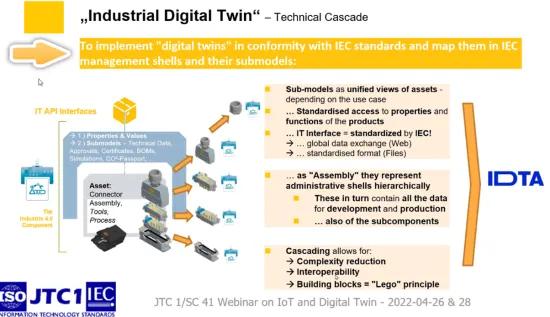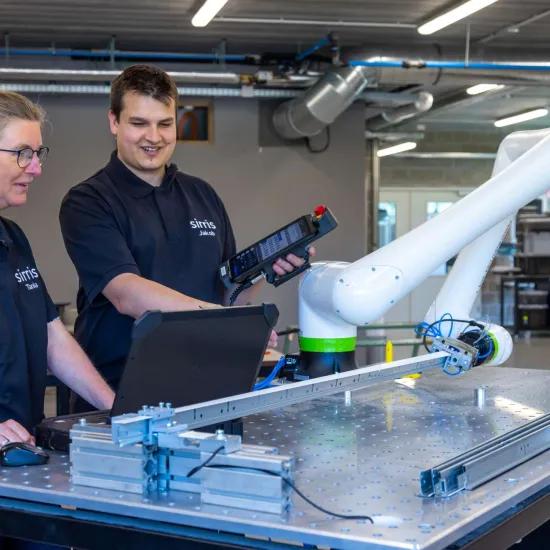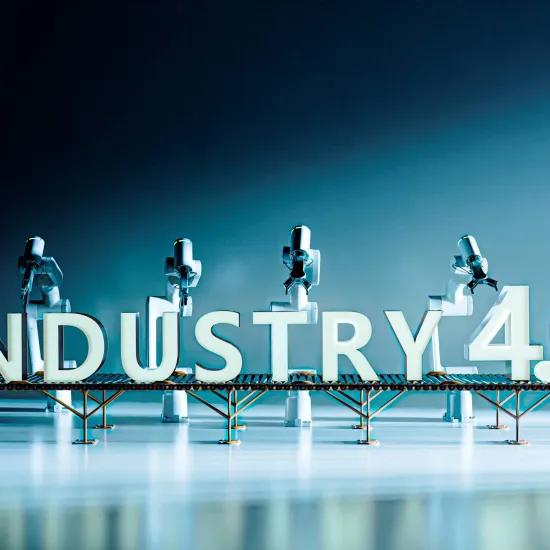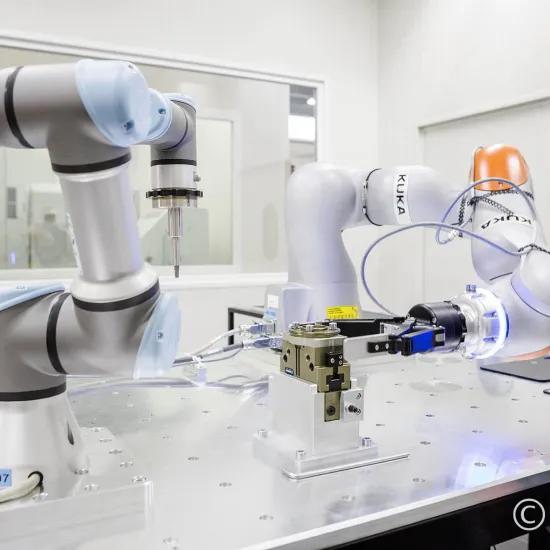As the digital transformation of our world accelerates, digital twin technologies are becoming indispensable tools in a very wide number of areas and domains. IEC and ISO are working hand in hand on defining the concepts and the use cases relevant to move standardization forward.
A digital twin must represent the physical reality at a level of accuracy suited to its purpose, leading to the need to agree on requirements for data, model and visualisation quality. The challenge is to specify principles and requirements at a level that remains generic enough to be used throughout the different domains covered by IEC and ISO.
The joint ISO/IEC subcommittee dealing with IoT and digital twins is ISO/IEC JTC 1/SC 41.
Definition
Did you know that today the term 'digital twin' is defined differently in different standards? Search for digital twin terms on the ISO Online browsing platform and see for yourself.
Terminology and concept definition are the biggest challenges for the standardization work. IEC and ISO need to define concepts so that they can be used in all the different areas where digital twins are expected to have an impact. Moreover, they also need to integrate existing domain-level standards. For instance, ISO TC 184/SC4: Automation systems and integration-Industrial data, has published in 2021 a series of standards on digital twins for smart manufacturing.
The ISO 23247 series “Automation systems and integration — Digital twin framework for manufacturing” defines a framework to guide the creation of digital twins of observable manufacturing elements, including personnel, equipment, materials, processes, facilities, environment, products, and supporting documents. These standards define the data architecture for digital twins in a manufacturing context. All of the parts were developed as an integrated package :
- Part 1: Overview and general principles.
Provides overview of digital twin manufacturing and describes general principles to give guidance for developing a digital twin manufacturing framework; - Part 2: Reference architecture
Provides reference architecture goals and objectives, reference model, and reference architectural views; - Part 3: Digital representation of manufacturing elements
Identifies the manufacturing elements of the digital twin manufacturing framework that shall be represented in digital models and gives some examples of static and dynamic information attributes. At the present time, several standards define information for one or more of the observable manufacturing element (OME) types but no single standard defines information for all the OME types. Existing standards and specifications, including ISO 10303 (STEP), IEC 62264 (ISA-95), IEC 62714, ISO 13399, eCl@ss, Asset Administration Shell (AAS), IEC 62541 (OPC-UA), MTConnect, ISO 23952 (QIF), and RDF can be used to represent the OME. An implementation of ISO 23247 shall select the models most appropriate for its use case. - Part 4: Information exchange
Identifies technologies such as network protocols, APIs, description languages, etc., for information synchronization, exchange and management of digitally represented manufacturing twins.
The ISO 23247 framework is based on the IoT reference architecture ISO/IEC 30141 . The functional entities of ISO/IEC 30141 are customized for manufacturing. Implementations of ISO 23247 may re-configure the entities in figure 1 in an appropriate manner.
ISO 23247 partitions a digital twinning system into layers defined by standards. Figure 1 above shows the four layers. The lowest layer describes the observable manufacturing elements. This layer describes the items on the manufacturing floor that need to be modelled. Officially it is not part of the framework because it already exists. The second layer is the device communication entity. This layer collates all the state changes of the observable manufacturing elements, and sends control programs to those elements when adjustments become necessary. The third layer is the digital twin entity. This layer models the digital twins. It reads the data collated by the device communication entity and uses the information to update its models. The fourth layer contains user entities. These are applications that use the digital twins to make your manufacturing more efficient. They are legacy applications such as ERP and PLM, and new applications that make processes work more quickly.
Would you like to see ISO 23247 in action? ISO TC184/SC4/WG15 offers a demonstration of all of the above. Check out the full video of the presentation here.
- Introduction/Closing (Martin Hardwick)
- Use Case 1 - Flexible Schedule for Robot Drill & Fill Using Teams of Robots (David Odendahl Boeing)
- Use Case 2 - Weight Reduction for Complex Structures (Jan De Nijis)
- Use Case 3 - Increased Quality for Features and Tolerances (Bengt Olsson)
The use cases cited here are described in much greater detail in ISO 23247-4.
Standards for AAS
In addition to the work of ISO TC184/ SC4, IEC/TC65/WG24 is developing standards providing guidance for 'asset administration shell' (AAS). The concept of AAS (figure 2 and 3) is seen as one implementation that converts a physical twin into a digital twin.
It defines a semantic model that consists of a number of domain-specific sub-models in which all the information and functionalities of a given asset – including its features, characteristics, properties, statuses, parameters, measurement data and capabilities – can be described.
IEC 63278 series “Administration Shell for industrial applications” is composed of three parts:
- Part 1 : Asset Administration Shell Structure
- Part 2 : Information meta model
- Part 3 : Security provisions
Part 1 IEC 63278-1 was published in 2023. The other two parts will be published at the end of 2024
For further information : IEC 61406-1:2022 Identification Link- General Requirement
Five projects tackling the challenges
To leverage the challenges of terminology and concept definition across all vertical industries (manufacturing, urban, medical, etc), the joint committee working group ISO/IEC SC 41/ WG 6 is currently working on five norms. Two of them were published in 2023 :
- ISO/IEC 30172: Digital twin use cases, and
- ISO/IEC 30173: Digital twin concepts and terminology.
ISO/IEC 30172 is a collection of use cases in areas as varied as transport and autonomous mobility, energy, smart cities and buildings, smart homes, smart manufacturing, business management, health, to name just a few.
ISO/IEC 30173 establishes terminology for digital twin and describes concepts in comparison with simulation, cyber-physical system, asset administration shell, internet of things), focusing on the applications, ecosystems (see figure 2), lifecycle processes and classification of digital twins, as well as on the different stakeholders.
The three other projects are in development.
- ISO/IEC TR 30194 ED1 Internet of things (IoT) and digital twin - best practices for use case projects
- ISO/IEC 30188 ED1 Digital twin - Reference architecture
- ISO/IEC 30186 ED1 Digital twin - Maturity model and guidance for a maturity assessment
ISO/IEC TR 30194 will define a process for collecting use cases and maintaining them as future smart documents as we move towards machine readable standards, which can be defined as standards that are machine applicable, readable, and transferable.
ISO/IEC 30188 will identify architecture commonalities using guidance from ISO/IEC/IEEE 42010 (Systems and software engineering — Architecture description) as well as work from an advisory group (AG 8) inside ISO/IEC JTC 1 on a meta reference architecture.
ISO/IEC 30186 will focusing on various elements such as levels of autonomy, or levels of modelling.
To learn more, we advise you to purchase the standards for better descriptions with additional figures showing more details. You can find them here:
All information related to ISO TC184/SC4 is available on the ISO web site. A list of already published and purchasable subcommittee standards can be found on the dedicated pages.
You may follow the status of work of development of IEC 63278 series by consulting the IEC TC65 dashboard. At publishing date the documents will be available for purchase on CEB-BEC Webstore and/or on NBN shop)
The work programme and a list of already published and purchasable subcommittee standards of ISO/IEC JTC 1/SC 41 can be found on the dedicated pages.
If you have any further questions concerning these standards, please feel free to contact us!
More information can be obtained from the Sirris Standards Cells.







